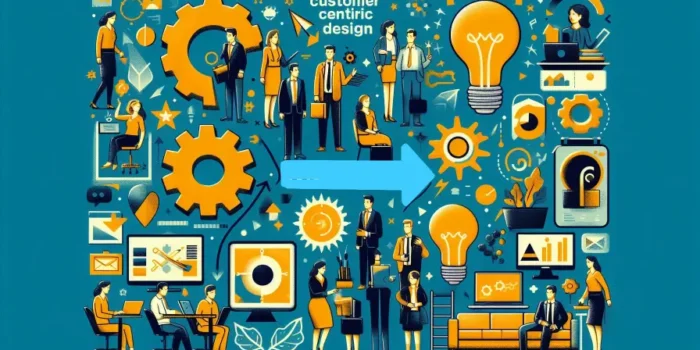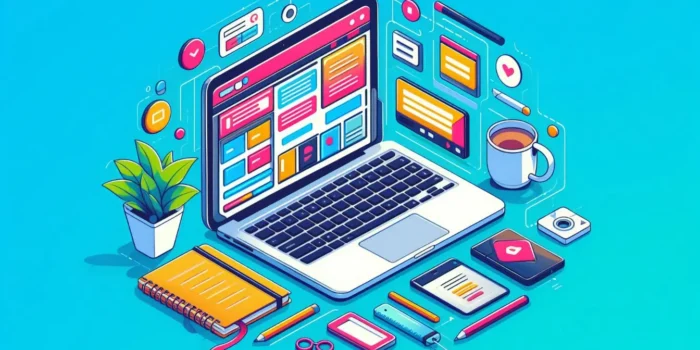More than just a buzzword that gets thrown around from time to time, digital transformation depicts an all-encompassing journey of digitization. More often than not, it’s referred to in an organizational context, but digital transformation can also be used to talk about massive industry changes, greater social paradigm shifts, or even the fluctuation of cultural standards from a consumer behaviour standpoint.
Let’s start with a basic definition; Digital transformation is the process of integrating digital technology into all aspects of an organization, drastically changing how you operate and provide value to clients. Firms must continuously challenge the established quo, experiment, and learn to embrace failure as part of this cultural transition. Digital transformation is necessary for all businesses, large and small. Every other lecture, discussion, article, and study about how businesses can stay relevant and competitive in an increasingly digital world conveys this message loud and clear.
The necessity of the hour is for an organization’s digital landscape to be redeveloped. From client acquisition and operations to post-sales service and customer service, companies will have to reimagine their operations throughout the full lifecycle. In the current context, an organization’s survival may be jeopardized if it does not digitally change to match the needs of the business landscape.
Rapid adaptation to the current scenario is also required for the successful distribution of products and services to clients, bearing in mind the pandemic’s safety concerns. Due to tight conditions in several areas, traditional global supply networks face numerous challenges. It’s critical to respond quickly to the pandemic’s impact on corporate procedures. We must first recognize that the post-pandemic era’s new normal will not be the same as the previous normal. In other words, digital trends and changes that reveal themselves beyond 2021 may be significantly different and unfamiliar.
Because of the expansion of social media platforms and web-based sales solutions, there has been a paradigm shift in how customers communicate with businesses. With digitization, the world has shrunk, and so have the markets! International competition is now competing in the same arena as domestic competition. No part of the globe is now too far away for business! Customer expectations for multi-channel availability and reaction time have shifted because of digital solutions. Businesses may adjust their products, services, interactions, and communications to meet the individual demands of their customers’ thanks to digital solutions.
However, before we can delve a little deeper into the aspects of digital transformation and what they mean for businesses in 2021, let’s dial back and talk about where this all started.
Digital Transformation: Everything You Need To Know In 2024
How did it begin?
The term “digital marketing” was coined in the 1990s. With the introduction of the internet and the development of the Web 1.0 platform, the digital era exploded. The Web 1.0 platform enabled users to find and share information, but it did not allow them to distribute it across the internet. Marketers all around the world were still apprehensive about the digital platform at the time. They weren’t sure if their plans would work because the internet hadn’t been widely adopted yet.
The first clickable banner was launched in 1993, and HotWired bought a few banner ads for their advertising. This was the start of the transition to the digital marketing era. As a result of this gradual transformation, new technologies entered the digital marketplace in 1994. Yahoo was founded in the same year. After its founder Jerry Yang, Yahoo was dubbed “Jerry’s Guide to the World Wide Web” and received about 1 million hits in its first year. As a result, the digital marketing landscape has changed dramatically, with businesses improving their websites to achieve higher search engine ranks. HotBot, LookSmart, and Alexa were among the search engines and tools that debuted in 1996.
Google was founded in 1998. MSN search engine was launched by Microsoft, whereas Yahoo web search was launched by Yahoo. The internet bubble burst two years later, and all of the smaller search engines were either left behind or wiped out, leaving more room for the industry’s behemoths. In 2006, search engine traffic was believed to have increased by around 6.4 billion in a single month, marking the beginning of the digital marketing boom.
Not wanting to fall behind, Microsoft put MSN on hold and created Live Search to compete with Google and Yahoo. Then came Web 2.0, which encouraged individuals to be more active participants rather than passive consumers. Web 2.0 enabled users to communicate with one another as well as with companies. The internet came to be labeled as a “super information highway.” As a result, the volume of information flow – including channels used by digital marketers – rose dramatically.
Customers can now access digitally advertised products at any time. According to Marketingtechblog’s 2014 statistics, posting on social media is the most popular online activity in the United States. The average person in the United States spends 37 minutes each day on social media. Facebook is used by 99 percent of digital marketers, while Twitter is used by 97 percent, Pinterest is used by 69 percent, and Instagram is used by 59 percent. Customers were acquired by 70% of B2C marketers on Facebook. 67 percent of Twitter users are more likely to buy from firms they follow on the social media platform. On Pinterest, 83.8 percent of luxury businesses have a presence. LinkedIn, Twitter, and Facebook are the top three social networking sites utilized by marketers.
Some sources estimate that by 2025, the digital transformation market will leap at a CAGR of 23 percent from its figure in 2019, paving the way to an accumulative $3.3 trillion in value.
The reason for this relentless growth from an enterprise standpoint is rather direct, most of the factors lead to digital transformation being a key part of an overarching competitive advantage for businesses to thrive in the future.
The impact on businesses
“Faster, better, cheaper” has been the business mantra for a while now. In reality, to successfully manage rapid change, corporations have invested a significant amount of money in novel approaches such as hackathons and sprints. The ability of a corporation to be effective is inextricably linked to its ability to be efficient. Employees’ ability to identify, integrate, and implement the transformations demanded by the environment determines efficiency.
To be successful in this vein, it’s critical to understand the contrasts between the following three fundamental concepts. They are as follows:
- Strategic Agility – the way a company decides to transform;
- Organizational Agility – how a company implements transformational processes and;
- Operational Agility – how quickly the transformation can happen
The methods in which these three agile methodologies are leveraged and employed to achieve digital transformation can be heavily influenced by a company’s vision and culture.
Beyond that, it’s the role of business leaders to stand at the forefront of the latest trends in various digital aspects as observers. It’s clear by now that every industry relies on some ongoing development associated with digital transformation, and the early adopters are most probably the ones with better chances at excelling past the next technological wave. Without understanding the prominent trends, you won’t be able to see what’s coming, and digitization will not be as empowering for you and your team.
Here are a few major trends to look out for beyond 2021 to give you a feel of what transformative phases are coming up.
Major Trends
Advanced Solutions for Customer Experience
Companies now have access to advanced analytics, which provides them with exact insights into client behavior, thanks to the rise of “smart” technology. As a result, businesses can now anticipate client behavior and respond to it seamlessly and effectively in real-time. “Smart” products enable businesses to better their relationships with customers and give them more seamless purchasing experiences. Employees can use these technologies strategically to interact with clients with the most advanced level of customization possible if they have a well-established business culture.
Innovation does not happen by accident; it is the result of carefully planned and targeted resources. It’s critical for businesses to swiftly find relevant and valuable digital changes, test the resultant innovations, and then capitalize on new tools, channels, or possibilities. Because consumers seek new technologies, it’s also critical to establish a culture that values creativity rather than fearing and avoiding it.
By finding new solutions that consumers are inclined towards, and adopting it into company channels, processes or systems, you’ll be able to foster a stronger connection with customers from the way they interact with your brand to the relevance your business resonates through UX design, unique product offerings or value-added extensions dedicated to optimal experience.
The Power of IoT for Localization and Retail
The internet of things, or IoT, is a network of networked computers, devices, mechanical and digital machinery, objects, animals, or people with unique identifiers (UIDs) as well as the ability to transfer data without human or computer contact. Organizations across a wide range of industries are increasingly turning to IoT to improve operational efficiency, better understand customers to provide better customer service, improve decision-making, and boost the value of their businesses. IoT devices not only connect and “speak” to one another, but they also collect data. This information may be transformed into insights, allowing organizations to gain a deeper understanding of their customers and their preferences, as well as give more options for personalizing client engagement.
Geolocation beacons, for example, may make local businesses more visible to the customers who are nearest to them, and those businesses can then send customized adverts and marketing messages to those customers, alerting them to customized offers and bargains while they are in or near a store.
Retailers can use computer vision – via cameras and other sensors – to obtain a better understanding of customer behavior and requirements as a result of the Internet of Things. Forbes Insights polled executives and found that 47% have adopted visual analytics across their organizations to capture information on people, things, and situations. Retailers, for example, can use on-floor cameras linked to artificial intelligence (AI) or analytic tools to better evaluate and anticipate client reactions to sales floor promotions, and alter plans accordingly.
The Rise of Big Data and Customer Data Platforms
One of an organization’s most significant assets is the data it collects. It needs to be used to its maximum capacity. To provide highly tailored and relevant insights, digital transformation uses both structured and unstructured data. Agility and real-time feedback are also enabled. Let’s look at a basic example to see why data-driven insights are so important. Digital marketing tactics are thought to be more reliable than traditional or non-digital channels since they provide quantifiable explanations based on real-world facts rather than just making qualitative suggestions. Companies may optimize their efforts and improve the results of marketing campaigns by using this real-world data. Organizations can increase income by focusing on key areas that are critical rather than putting effort into areas that are not of interest to customers by incorporating insights based on reliable data.
Naturally, such systems are highly valuable in the industrial industry, where sensors in production systems, assembly lines, warehouses, and vehicles will aid in predictive maintenance. Of course, proactive maintenance is far more efficient than reactive maintenance, as the ability to predict and avoid machine and equipment breakdowns decreases – if not eliminates – the danger of business disruption. It also aids managers in better understanding how operations run and gaining greater insight into the efficiency and effectiveness of their systems and processes, opening up new avenues for innovation and growth.
The Prominence of Mobile in Organizations
For a more solid, well-informed company model, mobile communication can include every employee contributing to the conversations that matter. Rather than being left out of the loop, wireless networks and mobile platforms allow both desk-based and mobile personnel to be in continual contact. Bulletin boards and snail mail are becoming relics of the past for traditional ways of commercial communication. Mobile-first digital communication systems are already commonplace.
To begin with, over 80% of the global workforce is mobile, with jobs that don’t require a desk, computer, or email. Second, the nature of desk-based occupations is currently evolving at breakneck speed. Companies have reviewed their people operations as the world slowly recovers from the COVID-19 pandemic. Companies began allowing staff to work remotely indefinitely before the crisis was resolved, and some even gave up their office locations. Secure file sharing on the move, document collaboration, and a variety of tools and software that allow employees to access company information at any time can all be leveraged to better the organization.
There are also a slew of other features, such as customer and sales tracking, and project management tools for organizing work and assigning them to the right people. Workers are also experiencing app and information fatigue as a result of the massive amount of paperwork and software tools required to access the information they require. To unify data, papers, and information, a mobile collaboration application establishes a single center for integrated systems.
Cooperative company structures powered by digitization
A strong organizational culture aids executives in rallying employees around a common goal, ensuring that everyone contributes to the company’s success. That’s all there is to it. The importance of collaboration and cooperation cannot be overstated. Companies are softly, but quickly, abandoning strict hierarchical structures today. Flat organizations that encourage collaboration are more creative and productive than those that are excessively vertical. The atmosphere created inside these flat structures is intended to promote effective staff communication. To establish collaborative eco-systems, collaboration with external partners and customers is also required.
In the end, the true potential of digital transformation is realized only by those who have the foresight to adopt the most promising digital practices and adapt according to current tides. Organizations must be fluid enough to implement tracking measures via customer data platforms, catch the most effective mobile-driven insights for better user retention, or find new and engaging ways to drive traction for marketing channels across the board. 2023 was a hectic year, and as we gear up towards 2024 it’s worth noting that digital transformation will be heading to new heights.
Suggested Reads:
[catlist categorypage=”yes”]





 Booking System
Booking System eCommerce
eCommerce On-Demand Services
On-Demand Services Community App
Community App Ordering App
Ordering App Loyalty App
Loyalty App Online Learning
Online Learning Directory
Directory Marketplace
Marketplace SaaS
SaaS P2P Platform
P2P Platform eHailing
eHailing Healthcare
Healthcare Finance
Finance Logistics
Logistics Education
Education Food & Beverage
Food & Beverage Retail
Retail FMCG
FMCG Sports
Sports Travelling
Travelling Manufacturing
Manufacturing Renewable Energy
Renewable Energy Mobile Application Development
Mobile Application Development Web Application Development
Web Application Development Source Code Review
Source Code Review Internet of Things (IoT)
Internet of Things (IoT) Cyber Security
Cyber Security